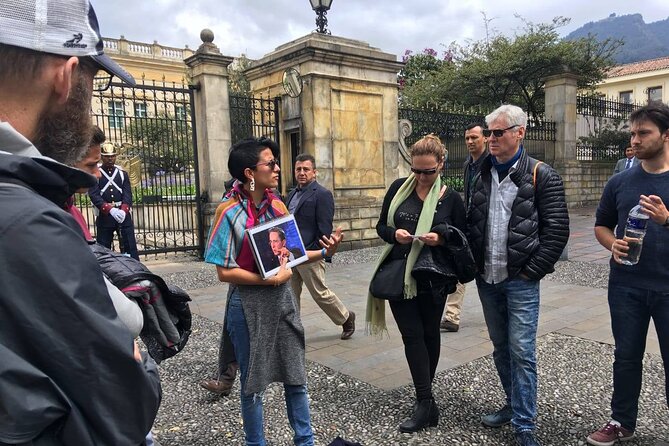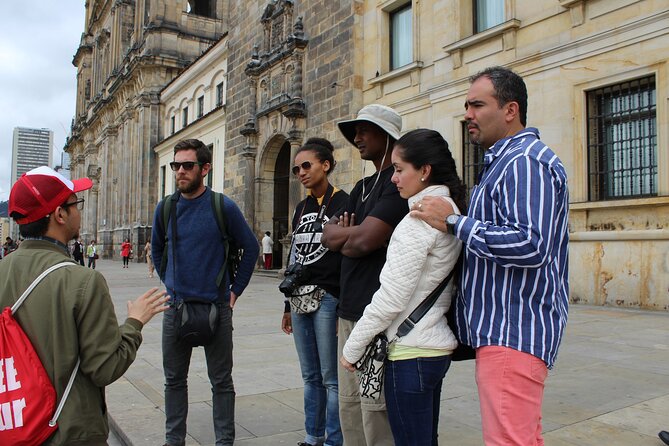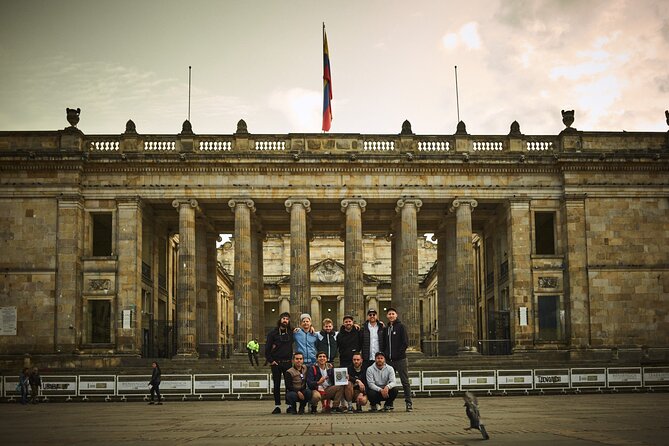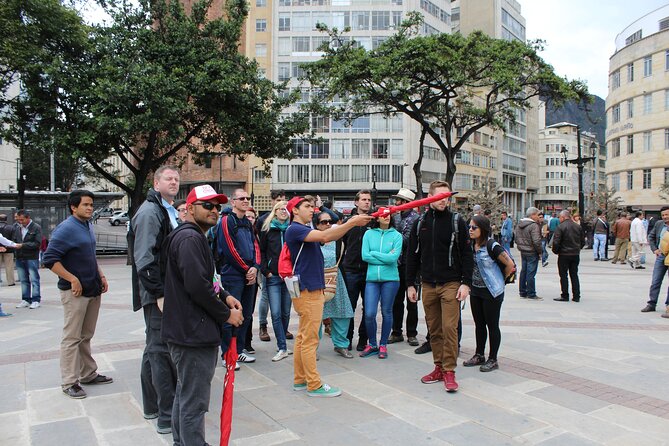Physical Address
304 North Cardinal St.
Dorchester Center, MA 02124
Physical Address
304 North Cardinal St.
Dorchester Center, MA 02124

The Colombian conflict is a complex web of war, drug trafficking, and arduous peace efforts. Fueled by decades of socioeconomic inequality, this turbulent history has given rise to powerful guerilla groups and notorious drug cartels. Yet, amidst the legacy of violence, Colombia’s people strive for reconciliation. A shared tour explores this intricate landscape, shedding light on the challenges and resilience that define the nation’s path towards a peaceful future.

You can also read our reviews of more tours and experiences nearby.

The Colombian conflict has been a prolonged and complex struggle, marked by decades of violence, political instability, and the influence of drug trafficking.
It’s rooted in socioeconomic inequalities, the rise of guerrilla groups, and the state’s efforts to suppress them. The notorious Medellín Cartel and other criminal organizations further complicated the situation through their involvement in the illicit drug trade.
In recent years, the Colombian government has negotiated peace accords, yet challenges remain in fully implementing them and reintegrating former combatants.
This tour provides an in-depth look at the conflict’s history, its impact, and the ongoing peace process.
As the Colombian conflict continued to rage, the influence of powerful drug cartels, such as the notorious Medellín Cartel, began to grow exponentially.
The cartel’s leader, Pablo Escobar, amassed immense wealth and political power through the cocaine trade. This led to:
Pablo Escobar’s vast wealth and influence through the cocaine trade led to widespread corruption and violence in Colombia.
Widespread corruption, as the cartel bribed government officials and law enforcement.
Increased violence, as the cartel fought to protect its operations and eliminate rivals.
Destabilization of the Colombian state, as the cartel’s activities undermined the country’s institutions and social fabric.
The rise of drug trafficking became a central aspect of the Colombian conflict, with far-reaching consequences.

Though the Colombian conflict involved a complex web of actors, several key figures emerged as central players in the decades-long struggle.
Emblematic of the guerrilla forces, Manuel "Tirofijo" Marulanda led the Revolutionary Armed Forces of Colombia (FARC) for over 40 years.
Conversely, paramilitary leader Carlos Castaño founded the United Self-Defense Forces of Colombia (AUC) to combat the FARC.
Meanwhile, notorious drug lord Pablo Escobar amassed immense power and wealth through the Medellín Cartel’s cocaine empire, exerting influence over both guerrilla and government forces.
These polarizing personalities shaped the trajectory of the Colombian conflict, leaving a lasting impact on the nation’s tumultuous history.
Although the decades-long Colombian conflict had far-reaching consequences, its impact on Colombian society was particularly profound.
The conflict:
Eroded trust in government and institutions, as Colombians grappled with corruption and the state’s inability to provide security.
Fueled internal displacement, with millions of Colombians forced to flee their homes due to violence.
Contributed to a culture of impunity, where perpetrators of atrocities often evaded justice.
The conflict’s legacy continues to shape Colombian society, posing ongoing challenges for reconciliation and social cohesion.

Alongside the conflict’s devastating impact, Colombia has also seen ongoing efforts to pursue peace and reconciliation.
After decades of war, the Colombian government and rebel groups have engaged in peace talks, leading to landmark agreements like the 2016 Peace Accords. Though challenges remain, these initiatives have aimed to disarm combatants, address grievances, and foster societal healing.
Victims’ groups, human rights organizations, and community leaders have also spearheaded reconciliation programs, providing support and seeking accountability.
While the path forward is complex, Colombians continue working to build a more peaceful and inclusive future, one step at a time.
The Colombian Conflict Tour takes an objective and informative approach to exploring the country’s complex history of war, drug trafficking, and the ongoing peace process.
The tour’s highlights include:
Visits to landmark sites that provide historical context and first-hand accounts of the conflict.
Discussions led by a licensed, certified guide who offers a balanced perspective on the issues.
Opportunities for travelers to ask questions and engage in thoughtful dialogue about the conflict’s impact and the path towards reconciliation.
The tour aims to educate and enlighten, encouraging participants to gain a deeper understanding of Colombia’s tumultuous past and its journey towards a more peaceful future.
As travelers embark on the Colombian Conflict Tour, they’re captivated by the guide’s captivating narratives that breathe life into the region’s turbulent history.
The guide leads them through landmark visits, offering insightful commentary on the devastating impacts of the conflict, drug trafficking, and the arduous peace process. Participants engage in thought-provoking discussions, gaining a deeper understanding of the complexities involved.
The tour provides a free map, a complimentary lunch, and an opportunity to reflect on the country’s resilience in the face of adversity.
Ultimately, the tour leaves a lasting impression, equipping visitors with a more nuanced perspective on Colombia’s troubled past and hopeful future.
How can travelers book the Colombian Conflict Tour? The tour is available through Viator and can be easily reserved online.
The Colombian Conflict Tour is available through Viator and can be easily booked online.
There are a few key things to know:
Reserve in advance: Space is limited to 25 travelers per tour, so it’s best to book early.
Pay later: Travelers can reserve their spot now and pay the guide directly on the day of the tour.
Flexible cancellation: Free cancellation is allowed up to 24 hours before the start of the tour.
The meeting point is at the Bogotá Gold Museum, and the tour concludes at the Teatro Colón Bogotá.
Travelers can look for the guide with a red Beyond Colombia umbrella.
We've Also reviewed these nearby tours and experiences
The tour organizers prioritize participant safety. They provide a licensed, certified guide who leads the group. The meeting and end points are near public transportation, and the tour is wheelchair accessible. Cancellation is available up to 24 hours in advance.
Yes, visitors can bring their own food and drinks on the tour. The tour description doesn’t mention any restrictions, so participants are free to bring snacks and beverages to enjoy during the walking tour.
There are no age restrictions for this tour. Children of all ages are welcome to participate. The tour is designed to accommodate families and travelers of diverse ages.
No special equipment or gear is required for the tour. Comfortable walking shoes and weather-appropriate clothing are recommended. The tour is designed to be accessible for all participants.
The tour involves a moderate amount of walking. According to the overview, it’s a group walking tour, so participants should expect to be on their feet for the duration of the approximately 3-4 hour experience.
The Shared Tour of the Colombian Conflict offers a powerful and insightful exploration of the country’s complex history. It delves into the intertwined issues of war, drug trafficking, and the ongoing pursuit of peace, providing a nuanced understanding of the challenges and resilience of the Colombian people. The tour’s approach encourages reflection on the lasting impacts of the conflict and the importance of continued efforts towards reconciliation and a peaceful future.